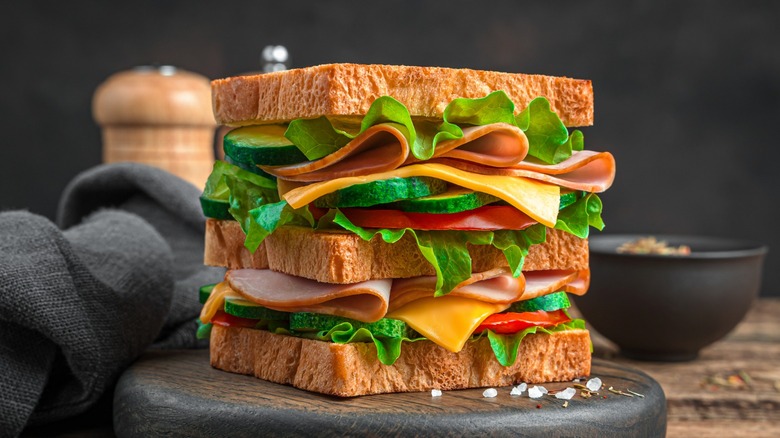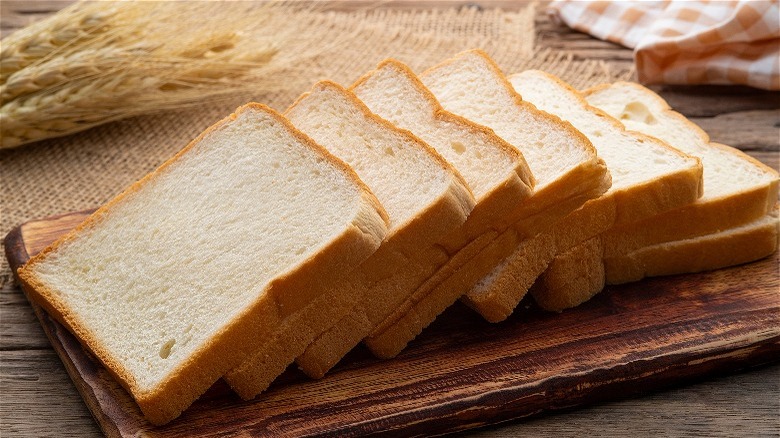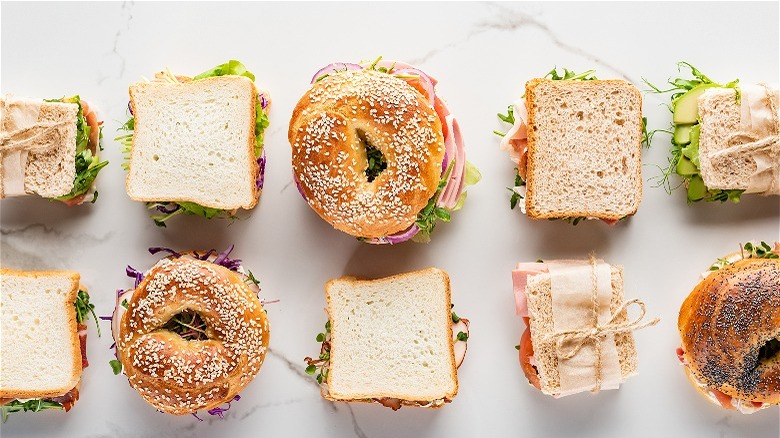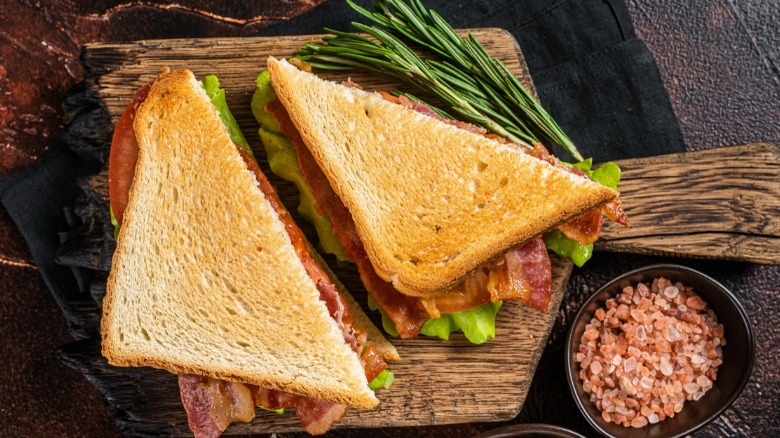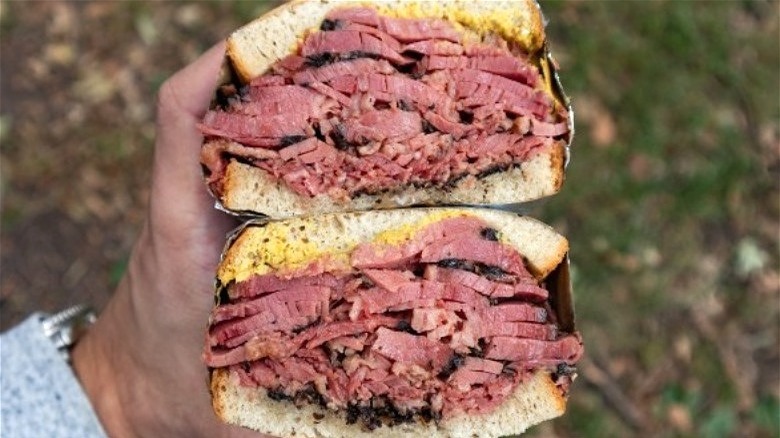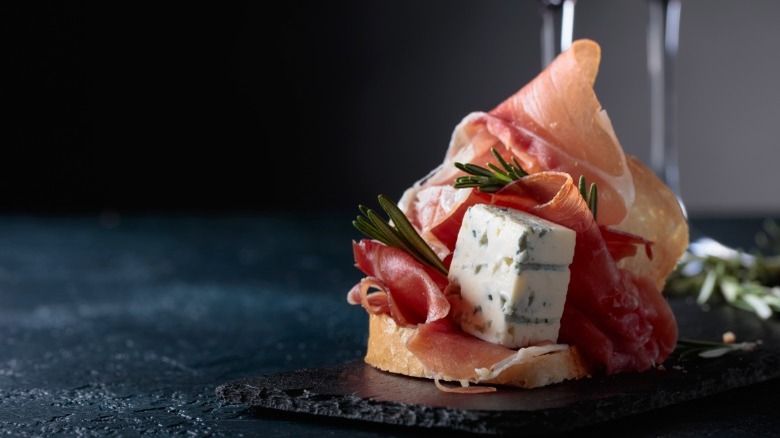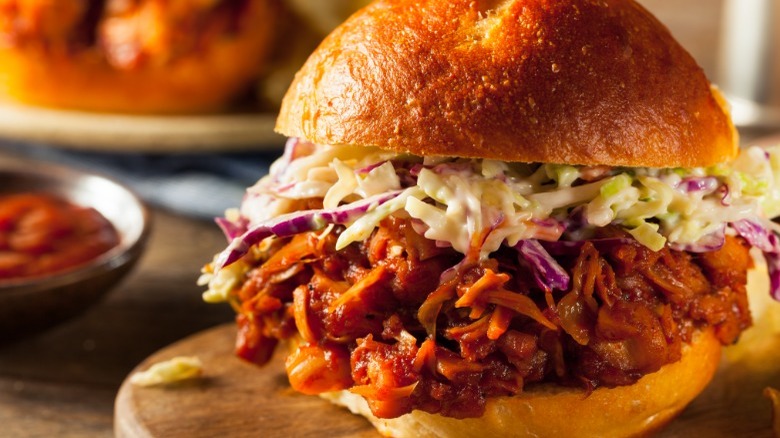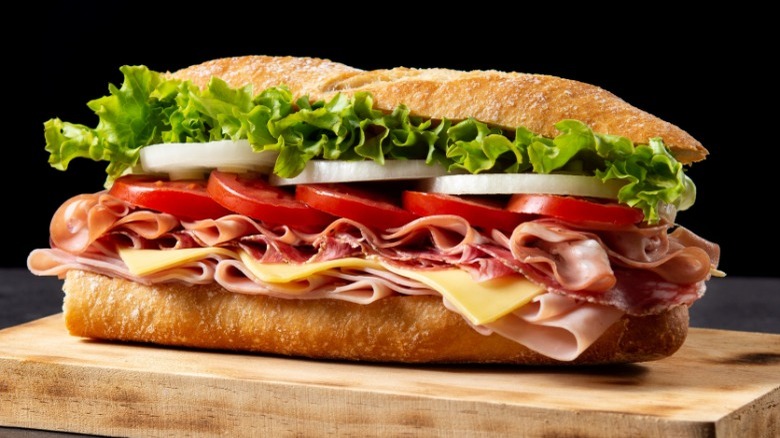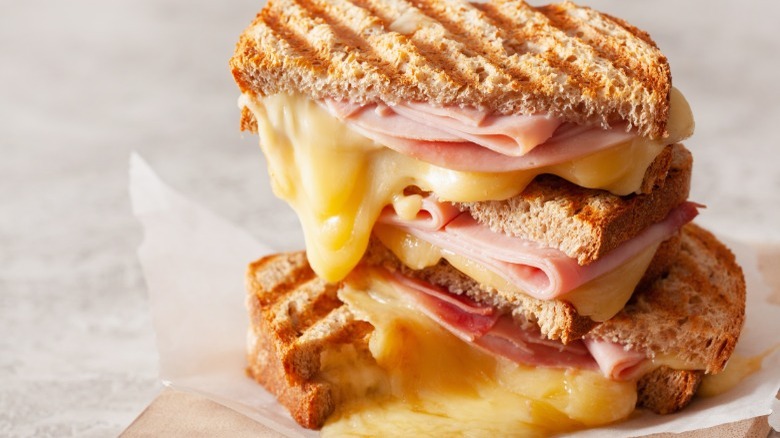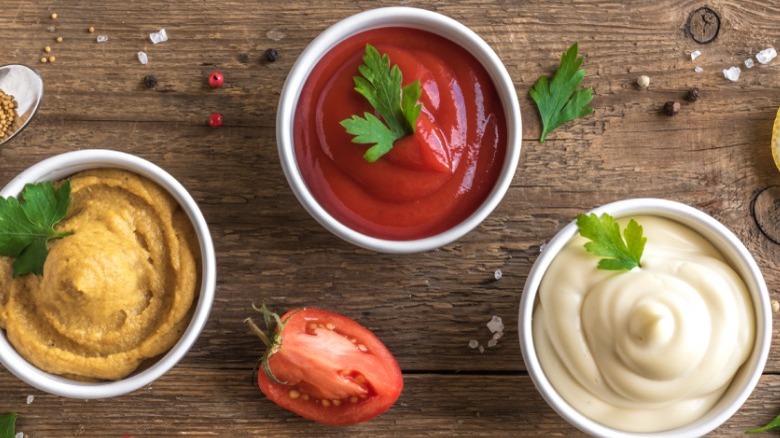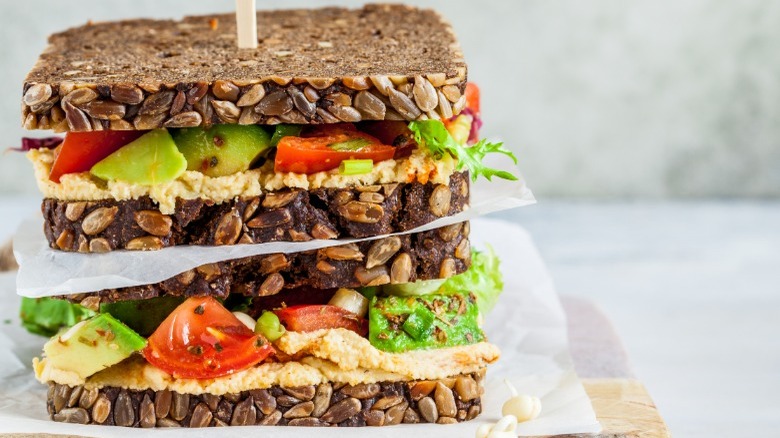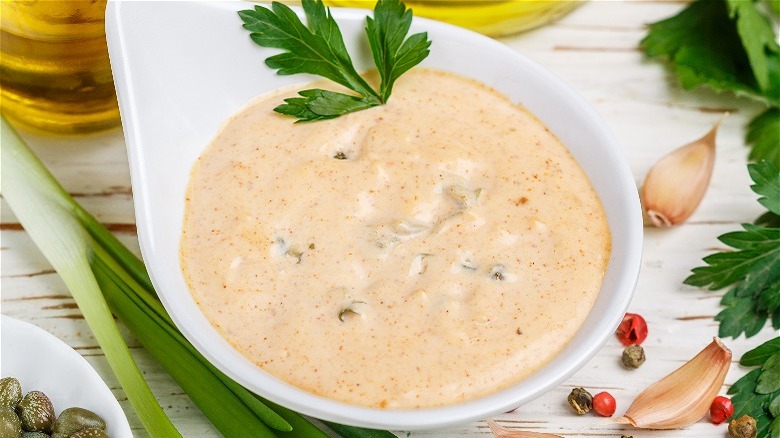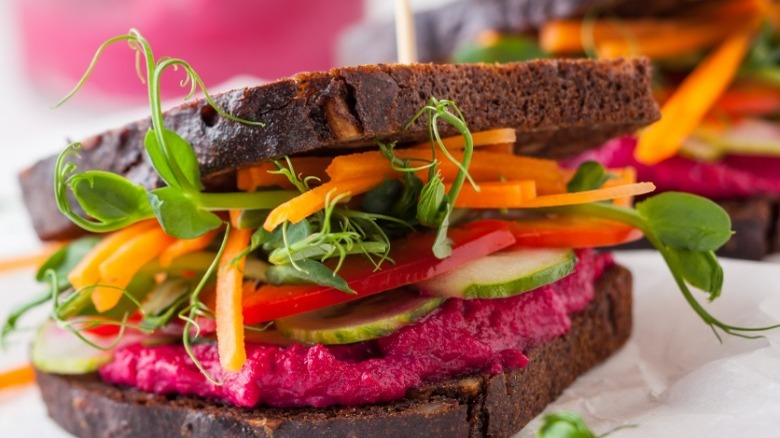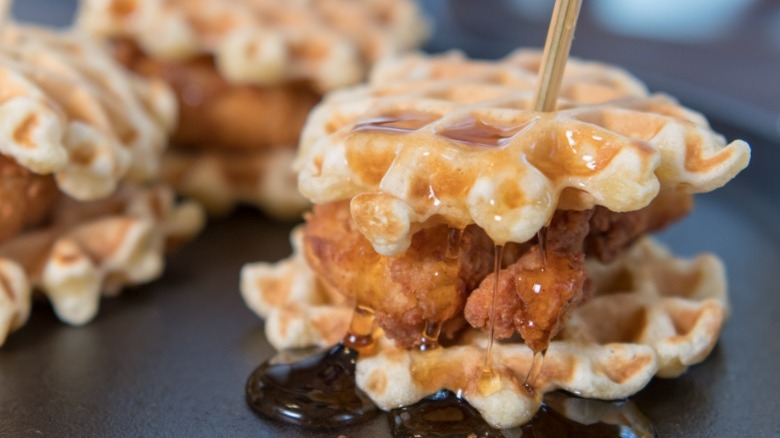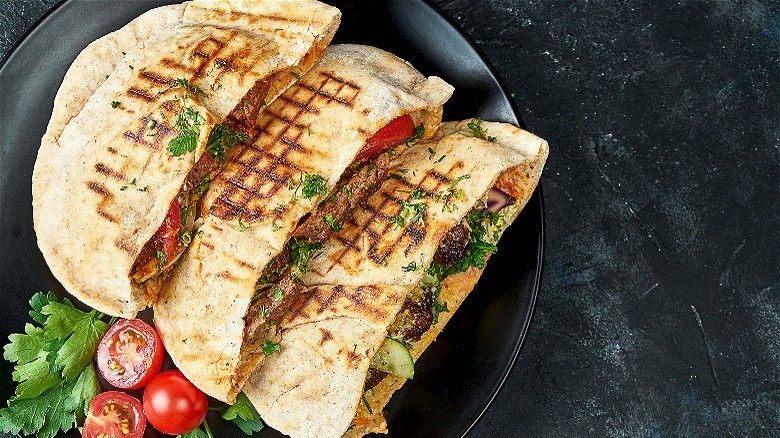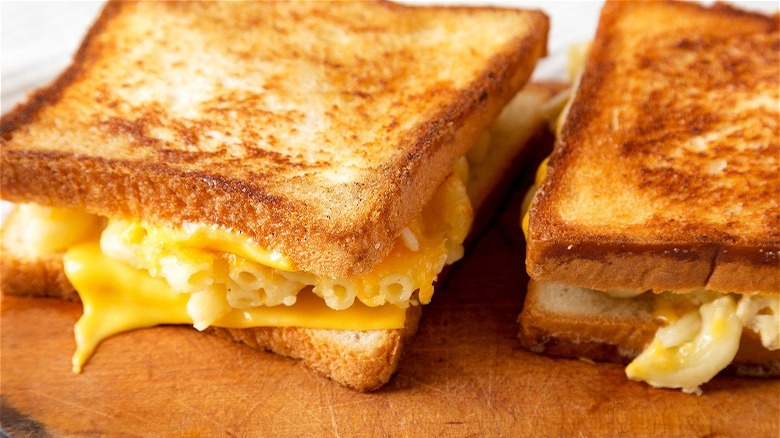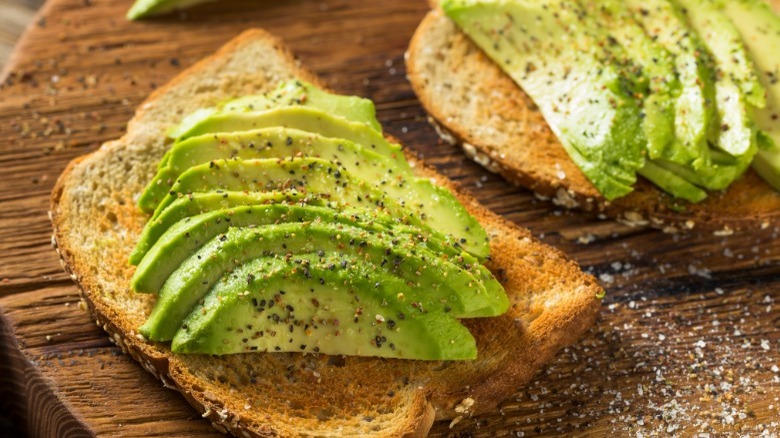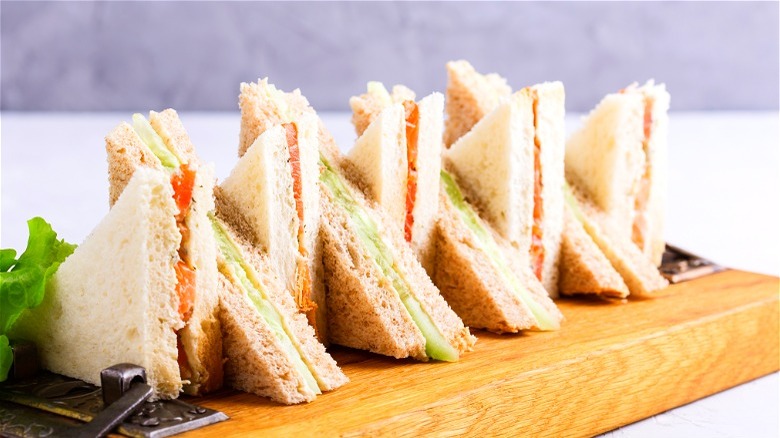17 Tips You Need To Make Restaurant-Quality Sandwiches At Home
Some dishes seem to always taste better at restaurants, and for some types of food, that's just the way it is. Unless you're a professional chef, it stands to reason that trained experts are going to perform better than you. Making a sandwich is a lot different than searing scallops, though. There's more assembly than actual cooking involved, so that means that even the most kitchen-averse among us can master the art.
If you can make a peanut butter and jelly sandwich or broil a toasted cheese, you've already got enough skills to put together a top-notch, restaurant-quality sandwich. You just need some pro tips to take it to the next level. The best part is that you can customize these tips to your own personal tastes, so the next sandwich you create will be even better than any restaurant could possibly offer because it's the best possible sandwich for you, personally.
Use fresh bread
Bread is the foundation of every sandwich. If you're not using good bread from the start, you might as well just eat your ingredients in a bowl. Fresh bread is one thing that most sets the restaurant-made sandwich apart from what you make for yourself. At home, your bread tends to sit around for a few days and sometimes even a week or more (in smaller households). Restaurants go through bread a lot more quickly, and good ones get deliveries of fresh bread every single day.
The very best sandwich bread measures its life in hours, which is why the best restaurants and delis bake their own. Take Langer's Deli in Los Angeles, for instance. One of the best Jewish delis in the U.S., Langer's reputation partly rests on its in-house baked rye, which elevates the pastrami sandwiches to the stratospheres of taste. You can choose to bake your own sandwich bread or pick some up from the local bakery. If you enjoy or only have access to commercially sliced bread, the sooner you use it, the better it's going to taste.
Match the bread to the sandwich
There's no reason you can't get creative with your bread selection, and sometimes it's a matter of what you have on hand. Many an empty pantry has led to peanut butter on a bagel or a hot dog on a hamburger bun. When you have a choice of bread, though, the proper pairing of the outside with the sandwich's insides can make a difference taste-wise as well as aesthetically. You wouldn't serve a lobster roll on an English muffin.
How to know which bread to choose? Think about the ingredients and what you want from them. Summer tomato sandwiches pair well with white bread because you want the fresh tomato to be the star. If you've ever eaten tuna salad on a baguette only to have it squish out the sides, you already know that soft fillings don't perform well with hard bread pressing down on them. A light, buttery croissant is a better choice for fillings like egg salad, tuna, or chicken salad.
Toast your bread
If you doubt the power of toasting your bread, consider the fact that no one would ever consider plain sandwich bread slices much of a breakfast. Pop those babies in the toaster, though, and now you've got toast. The simple act of heating bread until it is golden brown is so transformative it magically makes regular bread breakfast-worthy. Now imagine what it can do for your lunch.
While soft bread is recommended for some sandwich fillings (like the tuna salad mentioned above), others practically demand the presence of toasted bread. Notice that restaurants almost always lightly toast the bread for certain menu items like classic BLTs and club sandwiches. The toasting helps keep sandwiches from falling apart, making a barrier against the wet condiments and the produce, giving the structure a sturdy base and adding a pleasant crunch. Don't overdo the toasting — let the bacon be the winner in the crispiness contest. "Golden brown" should be the golden rule.
Choose quality meats
Have you ever seen those skyscraper-like New York City sandwiches, like the ones served at Sarge's or Katz's? No one would want to plow through all of that meat if it were anything less than spectacular. Far too many people leave the "deli" part out of their deli meats, opting for highly-processed, pre-packaged cold cuts. Even if you don't care about the additives in them from a health standpoint, those components aren't exactly delicious.
For the best quality, head to an actual deli, whether that's the deli section of your local grocery or you're lucky enough to live near a dedicated delicatessen. It's worth the splurge. Quality aside, another advantage is that you purchase deli meat by weight, so you can buy only what you'll use immediately, even if that's just enough for one killer sandwich. Buying small amounts means you can taste-test to your heart's content. Try a bit of prosciutto, some tasty mortadella, or finally, figure out the difference between your deli's different types of turkey.
Expand your cheese choices
Even the most humble of sandwich shacks will usually give you a choice of cheese. Choosing between American or Swiss is one of the customization choices we're most used to in the sandwich world. But there's more to life — and sandwiches — than plastic-wrapped cheese singles. A slice of sharp cheddar can perk up your everyday ham and cheese, while smoked Provolone adds an earthy depth to roast beef. Choose a pepper jack cheese to spice up your breakfast sandwich.
Take a cue from the restaurant world and go beyond the more-common slices. Good cheese comes in wedges, chunks, and crumbles, too. Seattle's Circa pairs salty bacon with creamy Brie, and you can easily recreate the combo at home. At Bub and Pop's in Washington, D.C., the four-cheese hoagie nixes the predictable choices in favor of provolone, Roquefort, Bulgarian feta, and pecorino. An intriguing cheese can instantly take your own sandwich to pro-level.
Balance your flavors
Have you ever thought about why some of the most classic sandwich pairings have endured so long? It's because their flavors work together in harmony. Salty, crunchy peanut butter balances the sweetness of jelly to create a masterpiece of peanut butter and jelly. The mild, nutty flavor of Swiss cheese balances the savoriness of ham in a classic ham and cheese. Think about what your sandwich has (is it spicy, salty, sweet, rich, sour, bland?), and you'll know what it needs.
At Hatty B's in Nashville, famous for its mouth-searing hot chicken, the sandwiches are topped with a cool and creamy cole slaw to cut the heat. At home, you can use cole slaw to balance your spiciest sandwich creations, but you could also turn to blue cheese, regular mayo, or aioli. Rich meats and cheeses can be balanced with something sour, like the sauerkraut in a Reuben or the pickles on a cheeseburger.
Stack it correctly
When you get a sandwich at Subway, they don't begin by squirting oil and vinegar directly on the bread. The result would be wet, soggy bread with an unpleasantly vinegary taste. Adding oil and vinegar at the end turns them into a light dressing for the lettuce and tomato. The order of ingredients in a sandwich can make a huge difference in how it tastes, its appearance, and its ability to hold together.
But doesn't putting condiments on top make the top piece of bread soggy? Actually, no. The moisture at the top of a sandwich trickles downward (because gravity exists), where it is stopped from penetrating the bottom slice of bread by the layer of meat and cheese. It's science, but it's not rocket science. Just remember to layer your substantial ingredients at the bottom and keep your condiments and produce at the top. (If you're packing a lunchbox, where a sandwich might sit for a while, a good bet is to put your condiments in the middle.)
Heat it up
Hardly anyone would choose a cold cheese sandwich over a hot, gooey grilled cheese. While the texture alone is better, it actually tastes better, too. Scientific research has determined that warm food actually stimulates our taste buds more than cold food, opening channels that send electrical signals to our brains. To the layperson, that means that steamy, hot food makes you say, "Mmm, good." Hot sandwiches are yet another way that restaurants beat your hastily-made concoction.
Fortunately, heating your sandwich isn't difficult, and the payoff is big enough that it's worth the time and effort. It can be as simple as putting the halves of your sandwich under the broiler until the cheese side is nice and bubbly or grilling the whole thing in a pan with butter for an extra-tasty exterior. It wouldn't kill you to use that panini press collecting dust in your cabinet, either.
Up your condiment game
The two most popular sandwich condiments in the country are mayonnaise and mustard, but that doesn't mean you have to stick with yellow mustard and Hellman's. (For starters, plenty of folks would kick you out of town for not using Duke's.) Mustard has a long refrigerator life, so you can try different versions and build a collection. Use Dijon for its sharp bite or stone-ground mustard for a rustic, artisanal vibe. Mayo, too, is available in different varieties, but you can easily stir in your own additions, like pesto or garlic, for a tasty flair.
Other condiments can elevate your sandwich if you pair them correctly. Steak sauce is a given on steak sandwiches, but you might find it gives a zippy taste to roast beef, as well. Ketchup is not very common on sandwiches, though folks who enjoy it on hot dogs might like it just fine on a bratwurst sandwich. BBQ sauce, sriracha, and balsamic vinegar — all could be worthy toppings for the right sandwich ingredients.
Get creative with spreads
If you want to get truly inventive with your sandwich, try incorporating spreads in lieu of typical condiments. Cream cheese, chutney ... the sky's the limit. The famous muffuletta sandwich— like the ones found at the iconic Central Grocery and Deli in New Orleans' French Quarter — gets its zing from a generous spread of olive relish. You can make your own olive relish for a muffuletta, but you can also add it to any sandwich you desire.
Dips aren't just made for chips and crackers. They can also add interest to a sandwich (which is also a clever way to use up any leftover dip after a party). Mediterranean veggie sandwiches are super with a layer of hummus or baba ghanoush. Guacamole pairs well with peppered deli turkey. Got leftover spinach and artichoke dip? Spread some on your grilled cheese before it goes in the skillet, and you'll have a sandwich to die for.
Make your own sauce
One of the ways restaurants make their sandwiches better is with signature sauces, from McDonald's special sauce to the housemade aiolis and béarnaise sauces of fine dining establishments. At Seattle's Poy Boy & Tings, the housemade "Syl Veu Plait" secret sauce is a big part of what keeps people coming back for their Louisiana-style sandwiches. If you make your own homemade version of a remoulade for your po' boys, you'll have a sandwich that's just as worthy of praise.
Whipping up a sauce is easier than you think, and once you use a recipe a couple of times, you will soon be able to do it off the cuff. Some sandwich-worthy sauces to add to your repertoire include hollandaise, honey mustard, blue cheese sauce, and horseradish sauce. You can even make a signature sauce with pre-existing condiments, just as this herb mayo recipe relies on ready-made mayonnaise to upgrade a club sandwich.
Vary your produce
Veggies add color and texture to a sandwich and brighten its taste, but too many people's idea of sandwich greenery is a few limp slices of iceberg lettuce. Think beyond the lettuce, and give that crisper drawer a workout. Thinly-sliced cucumbers, chunks of avocado, grated carrots, or bell peppers are all great sandwich additions. Fresh herbs like basil or cilantro can perk up even the dullest creation. Even fruit can be a game-changer: slices of apple or pear are a welcome contrast to sharp cheese.
No fresh produce on hand? That's what pickles are for. Preserved vegetables were made for times when produce pickings were sparse. Garlicky dills, bread and butter pickles, or fancy cornichons serve the same purpose as fresh veggies on a sandwich, with an added vinegary punch. Don't stop at pickled cukes. Other pantry items like roasted red peppers or Italian giardiniera can make your humble sandwich a winner.
Add a touch of sweetness
Most people think about savory ingredients when they think about jazzing up a sandwich, but a bit of sweetness can offer a delicious contrast. Sliced fruit, as mentioned above, is a good start, but don't be afraid to go even sweeter. Take a cue from the chicken sliders at Smoke & Fire in Las Vegas. The sandwiches are little flavor bombs, with fried chicken and jalapeño jack cheese topped with a sweet and sticky blueberry jam. If you're out of jam, a drizzle of honey can do the trick at home.
Sweet heat can be even more of a flavor powerhouse, so consider sandwich additions that bring both to the table. Hot honey, pepper or onion jam, and candied jalapeños are all genius-level ingredients for almost any sandwich. Sweetness doesn't have to be overly sugary. Caramelized onions impart a sweet, nutty taste to sandwiches without being cloying.
Go global
If you're in a sandwich rut, it might be because you're sticking to the old-fashioned American classics. There's nothing wrong with ham and cheese or good old-fashioned peanut butter and jelly, especially if that's what you like, but neither would get a lot of attention on a restaurant menu. Expand your sandwich horizons by making sandwiches from around the world. It only takes a little bit of know-how to turn a grilled cheese into a Croque Monsieur. A baguette and good butter can transform a ham sandwich into a French jambon-buerre.
Nearly every culture has its own version of a sandwich, from the crisp-crusted Vietnamese bánh mì to the meaty, overstuffed Mexican torta. If making homemade falafel is too much trouble, you can purchase falafel mix, and then you're just a loaf of pita bread away from a delicious falafel sandwich. If you want to keep things simple, you can still change things up with the beloved English bacon butty.
Mix and match
Restauranteurs are constantly coming up with new twists to keep their menus fresh. There's no reason you can't come up with your own. Think about ways of combining two of your favorite sandwiches into one new one. A saucy meatball sub and a grilled cheese can combine to become a meatball grilled cheese with a marinara dipping sauce. How about a double-decker tuna salad club sandwich? Or a hot PB&J made in your panini press?
Another way to twist up your lunchtime is by incorporating your leftovers into sandwich fillings. After all, that's how the meatloaf sandwich came to be. Leftover grilled salmon, fried chicken, or pot roast can be repurposed into tasty sandwiches for the next day. Even saucier leftovers can enjoy a new life. Try filling a pita with your chicken tikka masala, shrimp scampi, or leftover fajita veggies. Your next sandwich can be as exciting as a restaurant's new special.
Don't forget the seasonings
You'd never dream of skipping the seasonings on your favorite entrees, salads, or side dishes, yet when people make sandwiches at home, they almost always forget this important step. Can you imagine a baked potato without salt and pepper? Your sandwiches shouldn't have to suffer from a lack of seasoning. Give your sandwiches a few good twists from your trusty sea salt and pepper grinders, and you'll be amazed at the difference it makes in bringing out the flavors.
You don't have to stick with just salt and pepper. Raid your spice rack for spices and seasonings to enhance each sandwich creation. Try some Old Bay on your tuna salad to give it a Chesapeake-inspired flavor. Curry powder can do wild things with your egg salad, and so can a dash of za'atar. A sprinkling of sesame seeds, wakame flakes, chili powder, or everything bagel seasoning will wake up any sandwich.
Think visually
It's often said that we eat with our eyes before we even taste the food. Sometimes restaurants will add leafy green lettuce to a sandwich to a sandwich simply for the aesthetics, just to keep it from being a big beige rectangle. Before you sit down to eat your creation, take a few more short minutes to ensure that it looks as good as it tastes. That might mean trimming the crusts, wiping away excess sauce or crumbs, or placing it on an actual pretty plate instead of a paper towel.
Simply cutting your sandwich on the diagonal is better than not cutting it at all, but consider cutting it into four and placing the triangles on their sides, club-sandwich style. This type of cut allows the fillings to really show off to their best effect. Break out the toothpicks and secure your sandwich with an olive or a cornichon, and you'll have a lunch worthy of Instagram. Don't be surprised if people ask where you went out for lunch.
